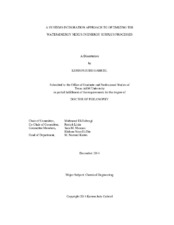| dc.contributor.advisor | El-Halwagi, Mahmoud M | |
| dc.contributor.advisor | Linke, Patrick | |
| dc.creator | Gabriel, Kerron Jude | |
| dc.date.accessioned | 2015-04-28T15:29:49Z | |
| dc.date.available | 2016-12-01T06:36:13Z | |
| dc.date.created | 2014-12 | |
| dc.date.issued | 2014-10-02 | |
| dc.date.submitted | December 2014 | |
| dc.identifier.uri | https://hdl.handle.net/1969.1/153910 | |
| dc.description.abstract | The objective of this research was to develop novel tools for systematically optimizing the benefits of the water-energy nexus in processes with surplus energy. The developed approach consists of the following problems: (1) screening of the processes to identify potential for cogeneration of water and power, (2) development of a flexible water generating process, (3) synthesis of the integrated water and power facility and (4) thermoeconomic analysis of the integrated process.
In the screening problem, a targeting and benchmarking approach was used to identify the limits of the process for producing water and power from surplus energy. Various designs of the process were explored to compare the effects of process change on the overall targets for water and power generation.
For the water generating process problem, a new mathematical formulation was proposed for the thermal desalination of saline water. The new formulation consisted of a mass flowrate decoupling approach that reduced the overall mass and energy balances to a linear programming (LP) problem. This approach was used to develop novel and flexible Multi-effect distillation with thermo vapor compression (MED-TV C) processes that balanced the tradeoff between economics and thermal efficiency.
In the synthesis problem, an integrated water and power generating facility was developed based on the excess heat sources from the process. The synthesis approach incorporated the use of four building blocks: (a) Total site analysis to identify appropriate steam level connections in the process, (b) heat exchange network synthesis for producing steam and boiler feed water utilities from excess process heat, (c) turbine network development for power generation and (d) water generation and integration via direct recycle.
In thermoeconomic analysis, the integrated facility from the synthesis approach was evaluated and optimized to maximize the intrinsic balance of the water-energy nexus. The analysis utilized extensive literature sources, fundamental chemical engineering practices as well as mathematical programming techniques to yield insightful conclusions.
The Gas-to-liquids process was strategically used as the case study to demonstrate the developed methodologies due to its ability to produce not only fuels and synthetic lubricants but potable water and power as part of its commodity portfolio. | en |
| dc.format.mimetype | application/pdf | |
| dc.language.iso | en | |
| dc.subject | Seawater desalination | en |
| dc.subject | Multiple effect distillation | en |
| dc.subject | Thermal vapor compression | en |
| dc.subject | Targeting | en |
| dc.subject | Optimization | en |
| dc.subject | MED-RO desalination | en |
| dc.subject | Water-energy nexus | en |
| dc.subject | Gas-to-liquids | en |
| dc.title | A Systems-Integration Approach to Optimizing the Water-Energy Nexus in Energy Surplus Processes | en |
| dc.type | Thesis | en |
| thesis.degree.department | Chemical Engineering | en |
| thesis.degree.discipline | Chemical Engineering | en |
| thesis.degree.grantor | Texas A & M University | en |
| thesis.degree.name | Doctor of Philosophy | en |
| thesis.degree.level | Doctoral | en |
| dc.contributor.committeeMember | Mannan, Sam M | |
| dc.contributor.committeeMember | Nasr-El-Din, Hisham | |
| dc.type.material | text | en |
| dc.date.updated | 2015-04-28T15:29:49Z | |
| local.embargo.terms | 2016-12-01 | |
| local.etdauthor.orcid | 0000-0001-6453-2258 | |


